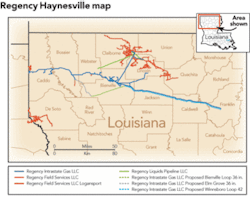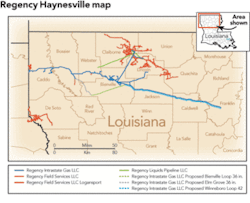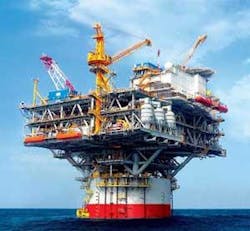Ex-Im Bank finances US exports to RIL for exploration, development in India
The Export-Import Bank of the US (Ex-Im Bank) recently approved a $400 million long-term loan guarantee to support US exports of equipment and services to Reliance Industries Ltd. (RIL) of Mumbai, India, for its onshore and offshore oil and gas exploration and production activities in the Krishna Godavari Basin in the Bay of Bengal.
RIL will use the financing for its purchases of US engineering services, oil field equipment, offshore platform support, and drill and well services. A small portion of the financing will be used to support ongoing work at the Jamnagar refinery, which received Ex-Im Bank support in 2007 and is currently under construction. The primary US exporters for this transaction, most based in the Houston area, include Bechtel Corp., J. Ray McDermott Inc., and Canyon Offshore Inc.
“India is a market with enormous prospects, and Ex-Im Bank is pleased to support this large energy-development transaction on behalf of American exporters. Our support helped to make their exports competitive in the face of significant international competition backed by foreign export-credit agencies,” said Ex-Im Bank chairman and president James H. Lambright.
RIL is India’s largest private-sector company by revenue, net profit, and total assets and currently operates the largest refinery in India and integrated petrochemical complexes in Maharashtra and Gujarat. The company recently expanded into offshore oil and gas exploration and production.
Ex-Im Bank has identified India as a key market for its export financing. In April 2008, Ex-Im Bank established the Indian Infrastructure Facility to support US exports to Indian projects. The facility now includes nine Indian financial institutions and has a financing capacity of $2.45 billion.
ExxonMobil begins work at Point Thomson to support drilling program
ExxonMobil Production Co. has completed initial barging of equipment and supplies to the Point Thomson drill site. ExxonMobil is operator of the Point Thomson unit.
The barges and tugs, operated by Crowley Maritime Corp., transported ice road and drill site construction equipment and supplies to the Point Thomson site located on Alaska’s North Slope. ExxonMobil is awaiting additional permits from State regulatory agencies necessary to allow drilling activities to continue.
The Point Thomson reservoir, located 60 miles east of Prudhoe Bay, is over 12,000 feet deep. The reservoir pressure of 10,200 pounds per square inch is abnormally high for the depth, requiring specialized drilling and well-completion operations to maintain well control. The project will require high pressure injection and fluid-handling facilities.
As part of the drilling program, a $20 million project is under way to upgrade the Nabors Rig 27E with new drilling mud and electrical systems to safely access the very high pressure Point Thomson reservoir. Casing pipe and wellhead equipment containing high-strength steel and special corrosion-resistant alloys is under manufacture, with delivery scheduled before year-end.
The project will cost approximately $1.3 billion, which includes a five-well delineation drilling program and a multi-year development to construct production facilities, pipelines, and support infrastructure. The upgraded Nabors rig will drill the first well during the 2008-09 winter season.
Under the initial phase, roughly 200 MMcf/d of Point Thomson gas is expected to be produced. Approximately 10,000 b/d of liquid condensate that is separated from the gas is planned to be delivered for sale through new and existing oil pipelines. The remaining gas will be injected back into the Thomson Sand reservoir to maintain pressure for continued hydrocarbon recovery and for subsequent gas sales.
ExxonMobil and the other Point Thomson working interest owners are proceeding with the project while they seek to resolve the dispute with the State over the Point Thomson Unit and leases. Other owners include BP Exploration (Alaska) Inc., Chevron USA Inc., ConocoPhillips Alaska Inc., as well as 23 additional companies.
Chevron to develop Hebron heavy oil project offshore Canada
Chevron Corp.’s wholly-owned subsidiary, Chevron Canada Ltd., and its co-venturers have finalized legal agreements with the government of Newfoundland and Labrador to develop the Hebron heavy oil project offshore the east coast of Canada.
The Hebron Field is located 210 miles offshore the province of Newfoundland and Labrador in 300 feet of water. Discovered in 1981, the field is expected to be developed using a gravity-based structure with integrated drilling and production topsides. Hebron contains an estimated 400 million to 700 million barrels of recoverable oil.
Chevron Canada Ltd. has a 26.63% working interest and is operator of the Hebron Project. The other partners are ExxonMobil Canada Properties (36.04%), Petro-Canada (22.73%), StatoilHydro Canada Oil & Gas Inc. (9.7%) and Oil and Gas Corp. of Newfoundland and Labrador (4.9%).
“The Hebron Project is key to our Canada growth strategy and is one of many projects in our North American portfolio that will allow us to grow our reserves and production,” said Gary Luquette, president of Chevron North America Exploration and Production.
“Chevron Canada is contributing to that anticipated growth in Atlantic Canada through our participation in the Hebron Project, through our ongoing financial interest in the Hibernia and Terra Nova offshore oil projects, and through our exploration in the Orphan Basin. Moreover, Chevron Canada is pursuing long-term growth through the development of legacy assets in the Alberta oil sands and Northern Canada.”
Analysts estimate ROV spending to reach $1.6B in 2008, $2.4B by 2012
Energy analysts at Douglas Westwood have published a new market study entitled, “The World ROV Report 2008-12.” One finding is that oil and gas industry expenditure on work-class ROV (remotely operated underwater vehicle) operations is likely to total $1.6 billion in 2008 and the market is set to reach $2.4 billion by 2012.
Lucy Miller, lead analyst commented, “Both offshore utilization and ROV dayrates have increased dramatically over the past five years and stand at an all time high. In the past year, ROV dayrates for Africa, Middle East, and the Caspian have increased by 42%, overtaking Norway which was until recently the most expensive region. Also shortages of skilled operators have caused personnel dayrates to grow by 47-50% in those regions.”
Deepwater
“The report is based on analyzing underlying demand drivers and ROV operator’s dayrates. Although oil prices have fallen of late, this is likely to be a short-lived phenomena as oil companies take a much longer term view. High levels of drilling activity and increased installations of subsea wells, pipelines, control cables and other hardware are to continue apace as shallow water oil reserves deplete worldwide and deepwater increasingly becomes one of the few remaining places where major oil finds can be made. The recent deepwater discoveries off Brazil announced by Petrobras are evidence of this – and, in deepwater, ROVs are a key enabling technology for drilling and field development,” said Miller. “In addition, increasing numbers of ROVs are required to service the thousands of underwater installations existing worldwide.”
More ROVs needed
The analysts conclude that over the next five years a total of 655 new work class ROVs will need to be built to satisfy the dual demands of market growth and attrition of the existing fleet. “Comparing the two five-year periods, we forecast total work-class ROV Capex will increase from $1 billion in 2003-7 to $2.1 billion in the years 2008-12.
null
New industry study underscores global revenue increase by $86B
The worldwide upstream investment of 232 oil and gas companies was unchanged at $402 billion in 2007, according to the 2008 Global Upstream Performance Review, released by oil and gas research firm IHS Herold Inc. and upstream corporate advisor Harrison Lovegrove & Co. Ltd., a Standard Chartered Bank company.
Record development spending, up 20% from 2006, generated just a 0.3% increase in reserve volumes to 264 boe. Acquisition spending fell 30% from 2006 record levels to $90 billion, but remained at a historically high level.
“Higher prices drove a 10% increase in revenue to $931 billion,” said Robert Gillon, IHS Herold senior vice president and co-director of equity research. “But cost pressures have been unrelenting, with lifting costs rising by 17% and government take up 5% to $253 billion, or 51% of pre-tax profit. As a result, net income edged up 2% to $246 billion, which is a record result but is far from the heady advances of the prior three years.”
Standard Chartered Bank managing director Rodney Schmidt commented, “A positive result is that oil and gas producing operations generated cash flow of $430 billion in 2007, up 10% from 2006, which is larger than capital outlays by about 7%. However, emerging issues, such as potential structural changes to demand and the impact of waning prices while cost pressures remain, will undoubtedly impact the industry’s performance going forward.”
The IHS Herold/Harrison Lovegrove study found returns to oil industry shareholders during 2007 remained robust. Dividends increased 11% to $92 billion, and common share repurchases totaled $94 billion, 5% higher than in 2006. Combined, these payouts amounted to just over 50% of corporate net income and the payout ratio has been virtually unchanged over the past five years.
Black Elk completes successful field rejuvenation program off Louisiana coast
Black Elk Energy LLC, a newly formed, independent oil and gas company, has garnered successful results from a field rejuvenation and workover program in the South Timbalier Block 8 Field (ST8), located in Louisiana state waters. Black Elk Energy owns 100% interest in the ST8 field.
After a $5 million dollar investment in facility modifications and well workovers, production has been doubled to six and one-half MMcfd of gas and 300 bpd. Currently operating 4 wells, the field development program has included recompletion work that exploits what were sunset wells. Reentry on 4 wells was performed and new zones of production were established. The work scope primarily involved exploiting identified pay additions and water shut-off procedures on selected wells after a surveillance program identified extraneous water sources. A fifth well is in the planning stages and is expected to add four MMcfd of gas and 200 bpd.
“This is the first major field redevelopment for Black Elk Energy and we are proud to bring these tremendous results to our investors,” said John Hoffman, president and CEO. “There are additional drilling opportunities at ST8 that will be undertaken as part of a Phase 2 redevelopment program later in 2008 and into 2009.”
Houston-based Black Elk Energy was founded in 2007 by industry executives and has a geographic focus within the Southern Gulf Coast states. Within the geographic area, its technical focus is on low risk reservoir exploitation opportunities and operational improvements.


